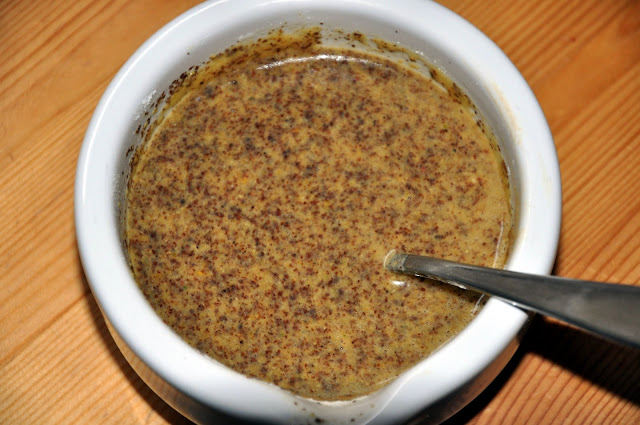What food items are staples in your kitchen? I recently read an article on the Healthy Eats blog about keeping healthy staples in the refrigerator. I really loved the idea of having cottage cheese, hummus, flour tortillas and almond butter on hand, but realistically these are rarely in my fridge. After reading this article, I thought of ways I could possibly improve my list of staples but first I wanted to explore those food staples that I depend upon week after week for my regular cooking and baking needs. And the best way for me to organize my thoughts is to make a list! Voila!
In my cupboards and elsewhere:
Lemons - I have really grown to depend on these lately. I can make my own salad dressing with lemon juice and olive oil. Having it nearby for a quick chicken piccata is essential. Lemon enhances our palate's ability to taste flavors (in a different way than salt does) so it really is a must have.
Onions - I always have a yellow onion on hand. Onions are such a core staple amongst so many savory dishes. And I get such a perverse joy out of chopping them. I love onion flavor so it's not rare to find leeks, chives and green onions in my fridge and onion powder and golden onion soup mix in my cupboards.
Salt - I know this seems like a given, but I always have a special salt imported from Aveiro, Portugal on hand. My father is originally from that town and I feel that using this particular salt keeps me connected with my heritage.
Vanilla - I have at least two bottles of Dominican vanilla available at all times. It's my signature ingredients for many a dessert and like the Portuguese salt, it connects me with my heritage as my mother is from the Dominican Republic.
White Wine - I love creating meals with white wine sauces so I stock up on little bottles of white wine. One small bottle is enough for a meal.
Canned Tuna - Packed in olive oil please, not water. Makes for a quick sandwich and it's great mixed into a pasta salad. It's often a protein in my meal and I will pair it with white rice, marinated baby beets and steamed greenbeans for one of my favorite go-to meals.
Canned Corned Beef Hash - Cook this in some olive oil with chopped onion, cubanelle pepper and red pepper. Then add some beaten egg and cheddar cheese and you have yourself an instant dinner.
In my refrigerator:
Cheddar Cheese - Shredded for macaroni & cheese, an omelet or scramble or for a salad. Thinly sliced on top of potato chips or by itself as a snack. The block lasts a decent amount time and I get a great deal for it at my main grocer.
Parmesan Cheese - A wedge of this is a must have. Shredded on top of pasta and various other foods, it's a great hint of salty flavor.
Eggs - I get Wilson Farms eggs because they come from their own farm-raised chickens. Since I bake a lot, these are a must. Plus, in a pinch an omelet or a scramble makes for a satisfying dinner. I also do a lot of breading (I make chicken and eggplant parm often), so eggs are definitely necessary for that. I think this is the most multi-purpose staple of them all!
Fresh Fruit - Peaches, Nectarines, Honey Dew Melon, Cherries and Strawberries are all my favorite fruits to indulge in. Come summertime, my fridge is packed with these goodies.
Chocolate chips - Great for baking, but I also snack on these when I need a quick chocolate fix.
Peppers - Cubanelle peppers and red peppers are always in my fridge. They add texture, flavor and color to any dish I add them to. Cubanelles are preferable to me than regular green peppers because they are milder in flavor.
In my freezer:
Chicken Breasts - Individually wrapped ones from Perdue. Chicken is so versatile and it's so incredibly easy to build a whole meal around it. I just have to remember to defrost them the night before!
Kashi Frozen Meals - They are an excellent choice for a quick and healthy lunch. I've never had one of these meals that I didn't enjoy.
Breakfast Items - Toaster Struedels, Aunt Jemima Frozen Breakfast Meals, Hashbrowns, Sausages, etc. Sometimes I get a craving for breakfast and having a few staples ready to go is handy. These are really indulgent so I only have them once in a great while.
----
What are your staples?
Angel Food Cupcakes with Raspberries and Lemon Curd Drizzle

I went to the grocery store today, fully intending to purchase an angel food cake from my grocer's bakery. I had plans to slice the already baked cake and drizzle lemon curd over the top. It would be a nice, light yet satisfying dessert for dinner. However, I saw that the angel food cake cost $5.99 and I couldn't quite overcome my sticker shock to purchase it. Instead, I headed over to the baking section and picked up a box of Angel Food cake mix for $2.39. Even in 90 degree weather, I'd rather save the $3.60 and bake the cake myself.
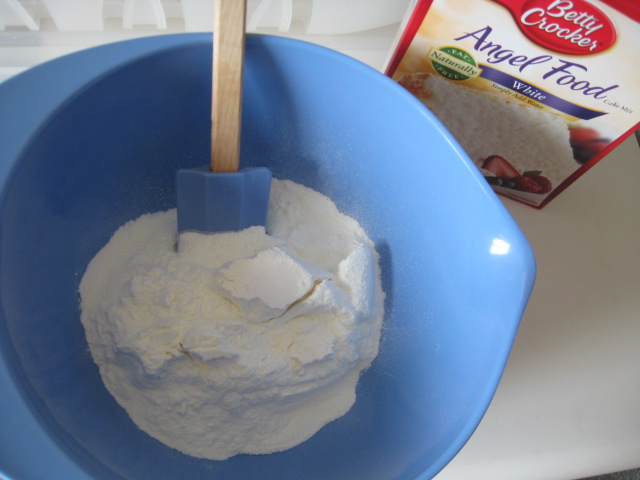
In my apartment, I don't have in the way of kitchen equipment and of course my kitchen repertoire is currently lacking a bundt pan, which is traditionally used for Angel Food Cake. If I wasn't going to spend the $5.99 on the cake, I sure as heck wasn't going to get a bundt pan. So I thought to myself, why don't I just make them as cupcakes?!
Angel Food Cake puffs up alot, both in mixing the batter and during the cooking process. So I only filled a cupcake tin 3/4 of the way up the sides with the batter, otherwise I thought the cupcakes would puff up too much and spill over. Make sure your cupcake tin is greased with some cooking spray. Cook the cupcakes for 8-9 minutes at 350 degress then cool. You'll need a spoon to pry loose the cupcakes from the tin as they'll stick, even though they are greased. Don't worry about flattening them as they'll puff up again.

Once you have all your cupcakes baked, heat some lemon curd and low heat in a pan. Heat the curd until it's consistency starts to give way and it becomes syrupy.
Take a few cupcakes and put them in a small bowl. Then sprinkle some fresh raspberries on top. Drizzle your warm lemon curd over the cupcakes and raspberries and voila! Enjoy.



Variation on a Crabcake
Do you have a signature recipe? One that you make over and over again and have fine tuned the ingredients and the methods until the result is nothing less than spectacular? Or are you in the middle of creating such a signature recipe?
I've been working for several months on creating the perfect crabcake and I've come pretty close to my ideal. The penultimate set of crabcakes I made were the most delicious thing I have ever tasted. I wasn't satisfied with just leaving it there, so I thought I'd keep trying new variatons on the crabcake recipe to see if perhaps something is better and my friend Jonas' mustard post gave me some inspiration!
With my developed crabcake recipe, I took out the lemon and added dijon mustard to the mix. The results were quite tasty. The dijon mustard gave it a bit of a tang and alongside the the mayo that I normally use, the crabcakes turned out deliciously moist inside. I also went slightly light on the breadcrumbs, which made the patties fall apart a little. I think I will continue to add dijon mustard to my crabcakes and be a bit braver with my breadcrumbs.
Ingredients:
1/4 diced small onion
1/4 diced cubanelle pepper
1/4 diced red pepper
2 14 oz. cans of lump crab meat
1 egg
3 tablespoons mayonnaise
2 tablespoons dijon mustard
chopped dill
salt
pepper
dry breadcrumbs to taste
Makes 6 crabcakes
One of the secrets of my method of making crabcakes (and omelets too actually) is sauteeing the vegetables in advance. To me there is nothing worse than eating something cooked and biting into raw veggies. Vegetables need some time to soften on their own and when you sautee in advance, they match the texture of the rest of the food much more evenly.

Sautee the onion, cubanelle pepper and red pepper in a bit of very light olive oil until the vegetables begin to soften. Set aside and cool. (Note that I ran out of cubanelle, so there are none in the pictures!)

In a bowl, add lump crab meat. For those of you who are crab snobs and are shocked that I use canned crab, I just get the really good stuff that is specifcally lump crab (not the gross shredded kind). If I were rich like you crab snobs, I'd get the fresh crab meat from the seafood market.
To the bowl, I then add egg, mayo, mustard, dill, salt and pepper. If you must, add Old Bay Seasoning. I don't think it's necessary and for my palate it weighs down the delicate balance of flavors in the crabcakes.

I mix all ingredients then slowly start to incorporate the breadcrumbs. I don't have a measurement for the breadcrumbs as I just add until the mixture is still moist but I can easily make crabcake patties with my hands.

If you are a newbie at crabcakes, fry up a small test patty before you make the whole batch of them. Watch if it holds together while frying and then taste it to see if you need more seasoning. You can adjust the mixture to your taste later.
I heat up some extra light olive oil, but you can use any light vegetable oil you want. I fry the crabcake patties, which I form with my hands, in batches of 3. Once they are brown and crispy on both sides, I move them to a papertowl where I salt them. You are going to want to salt them hot. This makes the crust of the crabcake even more delicious.

I serve the crabcakes with a light mixed salad. It's a nice balance of decadent and rich with fresh and light.
------
Do you have a recipe that you have fine tuned to perfection or that you are current working on? I'd love to hear your thoughts!

I've been working for several months on creating the perfect crabcake and I've come pretty close to my ideal. The penultimate set of crabcakes I made were the most delicious thing I have ever tasted. I wasn't satisfied with just leaving it there, so I thought I'd keep trying new variatons on the crabcake recipe to see if perhaps something is better and my friend Jonas' mustard post gave me some inspiration!
With my developed crabcake recipe, I took out the lemon and added dijon mustard to the mix. The results were quite tasty. The dijon mustard gave it a bit of a tang and alongside the the mayo that I normally use, the crabcakes turned out deliciously moist inside. I also went slightly light on the breadcrumbs, which made the patties fall apart a little. I think I will continue to add dijon mustard to my crabcakes and be a bit braver with my breadcrumbs.
Ingredients:
1/4 diced small onion
1/4 diced cubanelle pepper
1/4 diced red pepper
2 14 oz. cans of lump crab meat
1 egg
3 tablespoons mayonnaise
2 tablespoons dijon mustard
chopped dill
salt
pepper
dry breadcrumbs to taste
Makes 6 crabcakes
One of the secrets of my method of making crabcakes (and omelets too actually) is sauteeing the vegetables in advance. To me there is nothing worse than eating something cooked and biting into raw veggies. Vegetables need some time to soften on their own and when you sautee in advance, they match the texture of the rest of the food much more evenly.

Sautee the onion, cubanelle pepper and red pepper in a bit of very light olive oil until the vegetables begin to soften. Set aside and cool. (Note that I ran out of cubanelle, so there are none in the pictures!)

In a bowl, add lump crab meat. For those of you who are crab snobs and are shocked that I use canned crab, I just get the really good stuff that is specifcally lump crab (not the gross shredded kind). If I were rich like you crab snobs, I'd get the fresh crab meat from the seafood market.
To the bowl, I then add egg, mayo, mustard, dill, salt and pepper. If you must, add Old Bay Seasoning. I don't think it's necessary and for my palate it weighs down the delicate balance of flavors in the crabcakes.

I mix all ingredients then slowly start to incorporate the breadcrumbs. I don't have a measurement for the breadcrumbs as I just add until the mixture is still moist but I can easily make crabcake patties with my hands.

If you are a newbie at crabcakes, fry up a small test patty before you make the whole batch of them. Watch if it holds together while frying and then taste it to see if you need more seasoning. You can adjust the mixture to your taste later.
I heat up some extra light olive oil, but you can use any light vegetable oil you want. I fry the crabcake patties, which I form with my hands, in batches of 3. Once they are brown and crispy on both sides, I move them to a papertowl where I salt them. You are going to want to salt them hot. This makes the crust of the crabcake even more delicious.

I serve the crabcakes with a light mixed salad. It's a nice balance of decadent and rich with fresh and light.
------
Do you have a recipe that you have fine tuned to perfection or that you are current working on? I'd love to hear your thoughts!

Guest Blogger Jonas Thinks About Mustard
My good friend and fellow foodie Jonas (of the excellent All Talking! All Singing! All Dancing! and Lokomotivet blogs) has done me the honor of contributing this excellent post about that oh so elegant condiment, mustard. While the tang develops, enjoy the post!
--------------
Mustard is one of the oldest man made condiments there is still used widely today. Its origins are probably Roman and it was probably the the Romans who mixed unfermented grape juice, known as "must", with ground mustard seeds (called sinapis) to make "burning must", mustum ardens—hence the "must ard" in English or Moutarde in French. Other languages went back to the seed itself to give it a name. The German name is “Senf” and in the Scandinavian countries we call it Senap with some small variations in each country.
 Mustard seeds (top left) may be ground (top right) to make different kinds of mustard. The four mustards pictured are a simple table mustard with turmeric coloring (center left), a Bavarian sweet mustard (center right), a Dijon mustard (lower left), and a coarse French mustard made mainly from yellow mustard seeds (lower right).
Mustard seeds (top left) may be ground (top right) to make different kinds of mustard. The four mustards pictured are a simple table mustard with turmeric coloring (center left), a Bavarian sweet mustard (center right), a Dijon mustard (lower left), and a coarse French mustard made mainly from yellow mustard seeds (lower right).
There are many variations; almost every country has a standard mustard known to everyone. In some countries it is very important in others not so much. Sometimes it’s hot and peppery, sometimes very acid or close to marmalade in sweetness. It comes in many shades, from the brightest yellow to darkest brown. In my country, Sweden we like our mustard quite sweet, coarsely-ground but also quite hot. The main usage for mustard is of course together with sausages or hot dogs, any variety of ham but also for salmon of all sorts. Many families have their own secret recipes for mustard; I will let you in on mine which isn’t particularly secret but a typical Swedish mustard, suitable for the types of meat mentioned above. And it is really simple to make, and at all times much better than any mustard bought in a store.
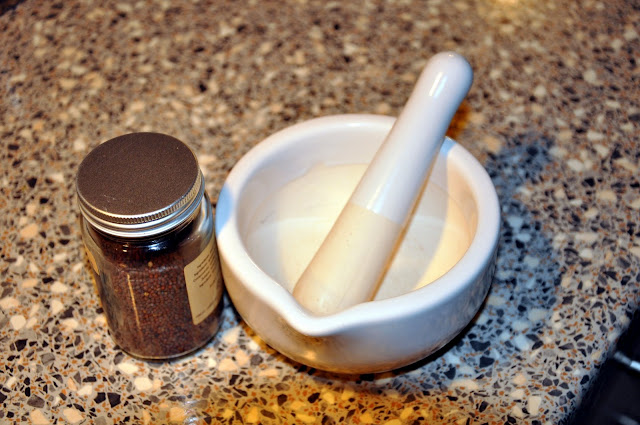
We need mustard seeds and something to grind them in. I prefer to grind seeds in a mortar as it gives me better control over how fine it will turn out. If you grind mustard seeds with an electrical device your mustard might turn out completely different from what you intended as it grinds much quicker. Remember that the “real” way do grind Swedish mustard is to roll it with a cannonball. Unfortunately cannonballs are hard to find these day so a mortar will simply have to do. In this recipe I use only black mustard seeds but yellow ones work just as well, or why not make it a 50/50 mix.
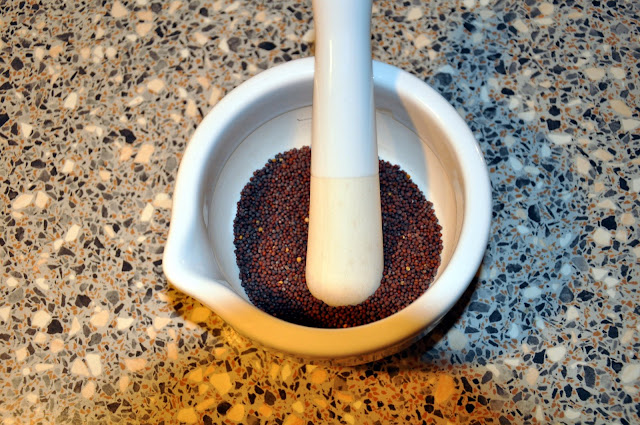
For a reasonable amount of mustard try about ½ decilitre or ¼ cup of seeds.
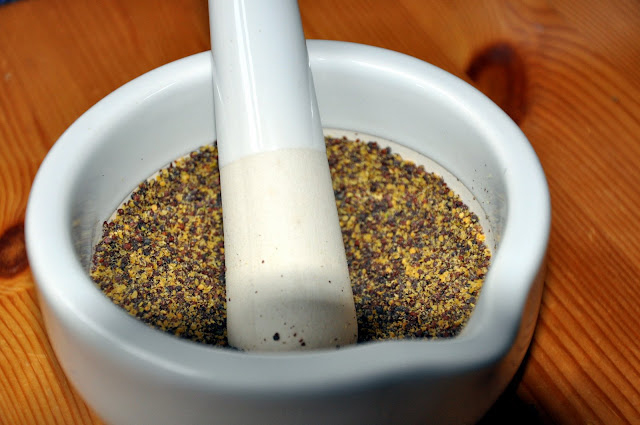
Then we grind it until it starts to stick to the mortar and smell really good. Add water or oil until it feels right. Cold water for mild mustard, boiling hot for a hotter mustard. A good mustard is never runny, neither should it be too firm.

Then add about a tablespoon of honey, a teaspoon of vinegar and a teaspoon of salt. At this point you have to taste the mustard to balance the sweetness, saltiness and acidity to a taste that you are comfortable with. At this stage it is also possible to add about a tablespoon of your special ingredient which could be an alcohol like whisky, rhum or Pernod. You could also give it a flavor of a spice of your choice depending on what you want to use the mustard for. Dill or Estragon are good choices. The more daring person could try a splash of strong coffee which I have heard is really good.

--------------
Mustard is one of the oldest man made condiments there is still used widely today. Its origins are probably Roman and it was probably the the Romans who mixed unfermented grape juice, known as "must", with ground mustard seeds (called sinapis) to make "burning must", mustum ardens—hence the "must ard" in English or Moutarde in French. Other languages went back to the seed itself to give it a name. The German name is “Senf” and in the Scandinavian countries we call it Senap with some small variations in each country.
 Mustard seeds (top left) may be ground (top right) to make different kinds of mustard. The four mustards pictured are a simple table mustard with turmeric coloring (center left), a Bavarian sweet mustard (center right), a Dijon mustard (lower left), and a coarse French mustard made mainly from yellow mustard seeds (lower right).
Mustard seeds (top left) may be ground (top right) to make different kinds of mustard. The four mustards pictured are a simple table mustard with turmeric coloring (center left), a Bavarian sweet mustard (center right), a Dijon mustard (lower left), and a coarse French mustard made mainly from yellow mustard seeds (lower right). There are many variations; almost every country has a standard mustard known to everyone. In some countries it is very important in others not so much. Sometimes it’s hot and peppery, sometimes very acid or close to marmalade in sweetness. It comes in many shades, from the brightest yellow to darkest brown. In my country, Sweden we like our mustard quite sweet, coarsely-ground but also quite hot. The main usage for mustard is of course together with sausages or hot dogs, any variety of ham but also for salmon of all sorts. Many families have their own secret recipes for mustard; I will let you in on mine which isn’t particularly secret but a typical Swedish mustard, suitable for the types of meat mentioned above. And it is really simple to make, and at all times much better than any mustard bought in a store.

We need mustard seeds and something to grind them in. I prefer to grind seeds in a mortar as it gives me better control over how fine it will turn out. If you grind mustard seeds with an electrical device your mustard might turn out completely different from what you intended as it grinds much quicker. Remember that the “real” way do grind Swedish mustard is to roll it with a cannonball. Unfortunately cannonballs are hard to find these day so a mortar will simply have to do. In this recipe I use only black mustard seeds but yellow ones work just as well, or why not make it a 50/50 mix.

For a reasonable amount of mustard try about ½ decilitre or ¼ cup of seeds.

Then we grind it until it starts to stick to the mortar and smell really good. Add water or oil until it feels right. Cold water for mild mustard, boiling hot for a hotter mustard. A good mustard is never runny, neither should it be too firm.

Then add about a tablespoon of honey, a teaspoon of vinegar and a teaspoon of salt. At this point you have to taste the mustard to balance the sweetness, saltiness and acidity to a taste that you are comfortable with. At this stage it is also possible to add about a tablespoon of your special ingredient which could be an alcohol like whisky, rhum or Pernod. You could also give it a flavor of a spice of your choice depending on what you want to use the mustard for. Dill or Estragon are good choices. The more daring person could try a splash of strong coffee which I have heard is really good.

Subscribe to:
Posts (Atom)

